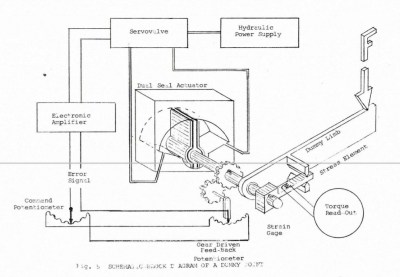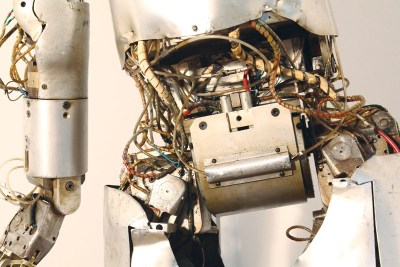If any of you have ever made a piece of clothing, you’ll know some of the challenges involved. Ensuring a decent and comfortable fit for the wearer, because few real people conform exactly to commercial sizes. It’s as much a matter of style as it is of practicality, because while ill-fitting clothing might be a sartorial fail, it’s hardly serious.
When the piece of clothing is a space suit though, it is a different matter. You are not so much making a piece of clothing as a habitat, and one that will operate in an environment in which a quick change to slip into something more comfortable is not possible. If you get it wrong at best your astronaut will be uncomfortable and at worst their life could be threatened.

In the early 1960s, NASA needed to quantify the effects of clothing such as a space suit on a human body. They could dress an astronaut in a suit, but while he could give them a subjective view of its comfort he could not quantise the forces it exerted on his body. Their solution to this problem was to construct a force gauge, an instrument designed to measure all the forces exerted by the suit as it simulated the full range of human movement. PDAD, the Power Driven Articulated Dummy, was the hydraulically driven humanoid result.
PDAD was designed to be adjustable to simulate a range of heights and sizes of typical American males, with a range of movement and torque capability as close as possible to those of a human within the constraints of the components available at the time. The actuators were hydraulic, and the control system was a fairly straightforward analogue servo system with an operator performing all the motions from a console. This meant that it was difficult for more than four joints to be in action at once, the limitation being the operator’s dexterity.

Two PDAD dummies were built during the programme, though problems with hydraulic leaks and overheating plagued their operation. Eventually NASA moved on from the project, and one of the dummies became part of the Smithsonian collection. The other found its way to the University of Maryland and thence to a private buyer, and is featured here because it is being auctioned later this month with an estimated price of $80,000. The auctioneer provides a wealth of photographs of the dummy, as well as PDFs of a contemporary engineering report on the project and period news coverage.
The PDAD dummy for sale is a little battered and worn, and seems to have lost its left elbow, forearm, and hand. There is no sign of the control console and it’s probably safe to guess that it’s not presented as a working example. However it is a fascinating glimpse into the depth and quality of the huge amount of work that went into the early years of human space flight, and if we are lucky it may find its way into another museum so we have the chance to see it at first hand.
The Smithsonian’s PDAD can be seen on their website, and is housed at the Steven F. Udvar-Hazy Center in Chantilly, VA. They provide the YouTube video shown below the break, of 1960s engineers testing the dummy.
Surprisingly this is the first time we’ve touched on the development of space suits here at Hackaday. We have however had a huge number of stories about other parts of the Apollo programme, which you can browse through the Apollo tag.
Via New Atlas, thanks: [Michael Boswell] for the tip.
Header image of the PDAD for sale: RR Auctions.















I don’t remember what it was called, but I watched a doc. about spacesuits development during the Apollo program. Quite fascinating as it involved many aspects that one wouldn’t necessarily think as high-tech such as sewing and garment making.
Then there’s the anecdote about the urine collection system, how it had to be a snug fit, and how the engineers had to convince the astronauts to order the size they really were rather than the size they thought they were or wished to be. (c;
Shoula just renamed the sizes huge, collosal, horse and liar.
IIRC, that was basically the revised sizing system the engineers came up with. (c:
You misspelled “Tall”, “Grande”, and “Venti”.
Old cold war joke, ‘The Russians sent an order for 100,000 condoms 6″ (15 cm) around and 12″ (30 cm) long. The company was concerned about this so they called the Pentagon and asked if they should fill the order or not? The Pentagon said “Yes, but label all the condoms ‘Medium’!”‘
Psyops still lives on today.
They should have just used a trick ruler ;-)
Buster doesn’t look so good…
Very interesting! It’s for sale; hope it finds a home visible to the public.
Anyone else would have used flexible multi-conductor jacketed cable, NASA hand assembled cables and hand wrapped them with Teflon $piral $tuff.
That teflon $piral $tuff is gonna hold up very well to wear from repetitive motions, far better than PVC insulation would, and a far better way to bundle the wires than with the traditional cord lacing of the day.
It doesn’t show up on the auction site when I click the link, and I couldn’t find it in a search.
Sadly due to the needs of editorial scheduling for more pressing topics the auction may by now have passed, I wrote this article a couple of weeks ago. Sorry about that.
Below is a link to an excellent book: “Spacesuit: Fashioning Apollo” about how the primary contractor, the maker of the Playtex brand, was uniquely suited (haha) to design and build the Apollo moon suit. It turns out that 1960s aerospace engineers did not really know how to work with fabrics or deal with the complexities of human kinematics. The key problem solvers in many instances ended up being the seamstresses on the production line who would demonstrate modifications to the engineers who would then send them back up the design hierarchy.
https://books.google.com/books?id=IT-chpAkCZ0C
Wasn’t this also the intended use for the pre-ATLAS PETMAN robot by Boston Dynamics?
yes.
Who else was expecting the test driod to break out in a moon walk.
I don’t see what the big deal is, I saw 2 power driven articulated dummies on TV Monday night.
does it come with the rubber gimp suit?